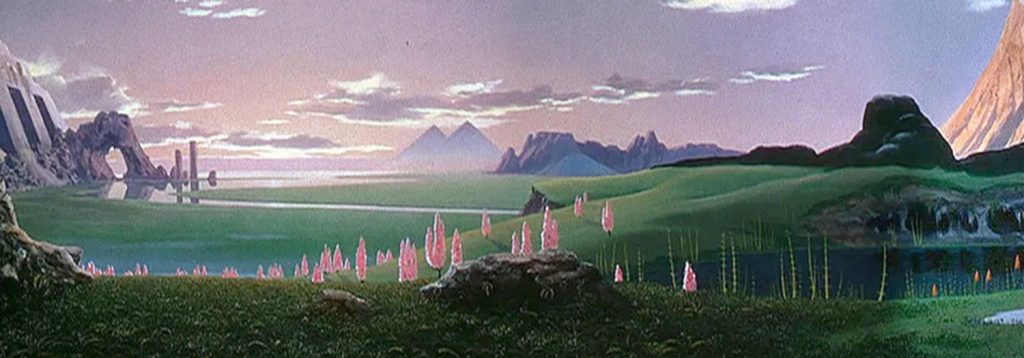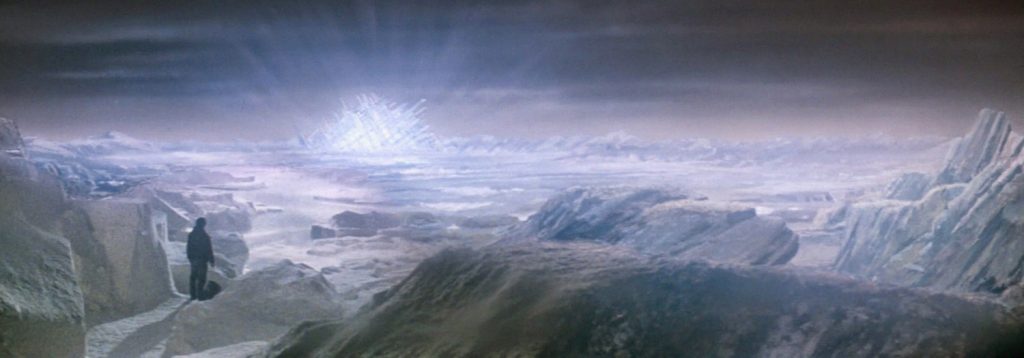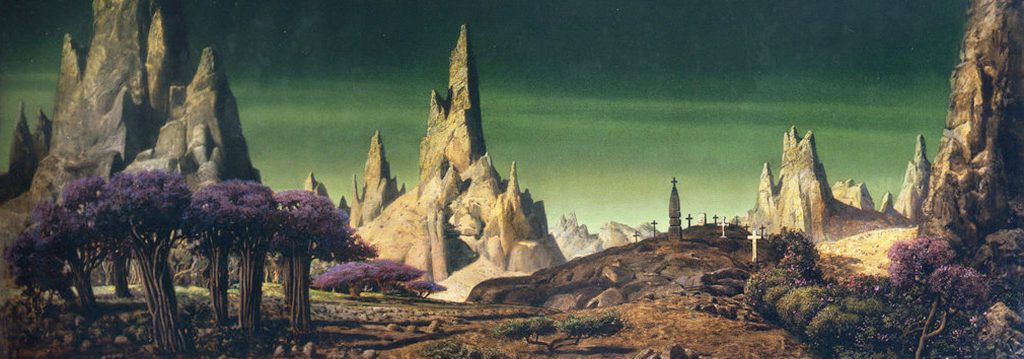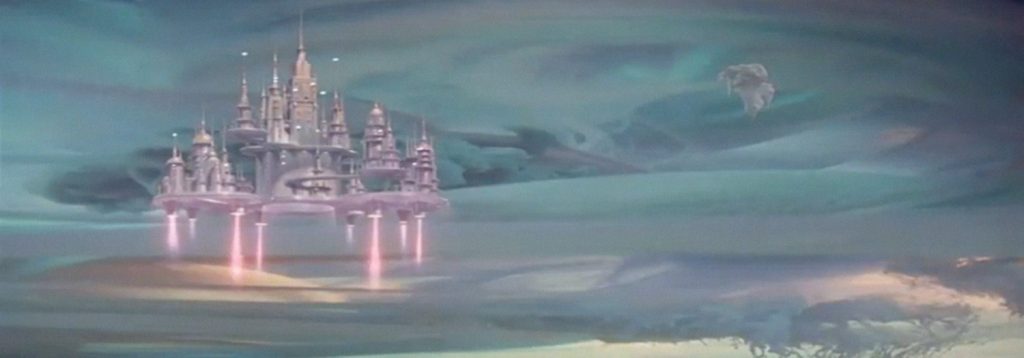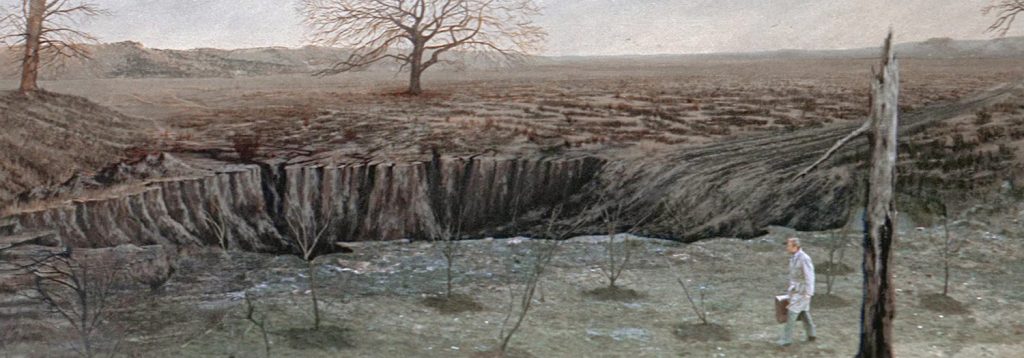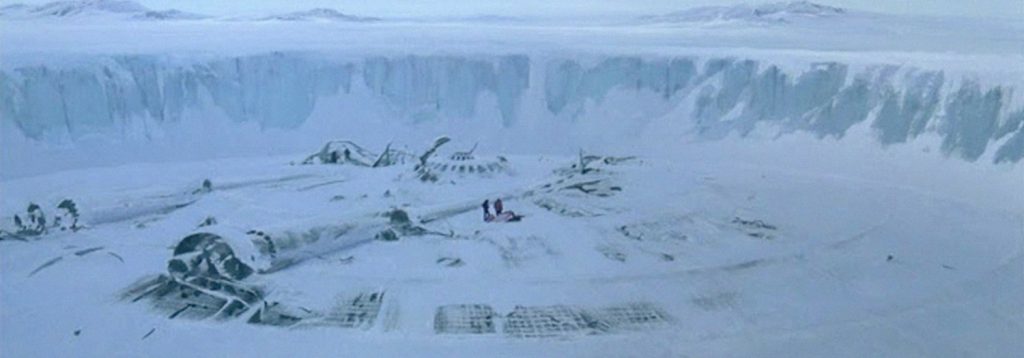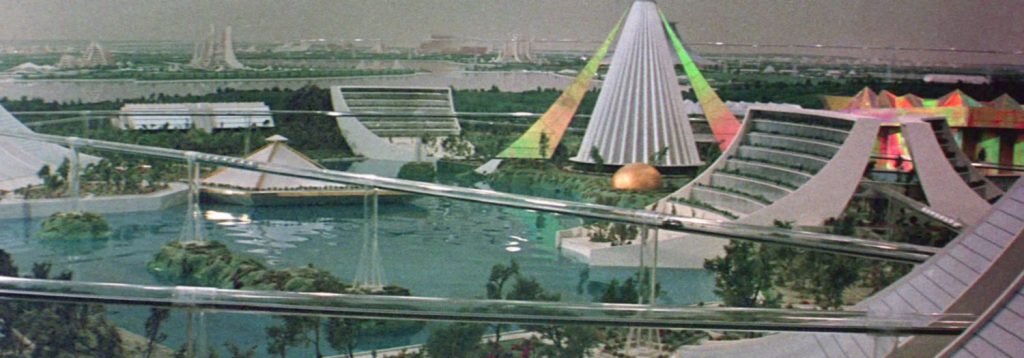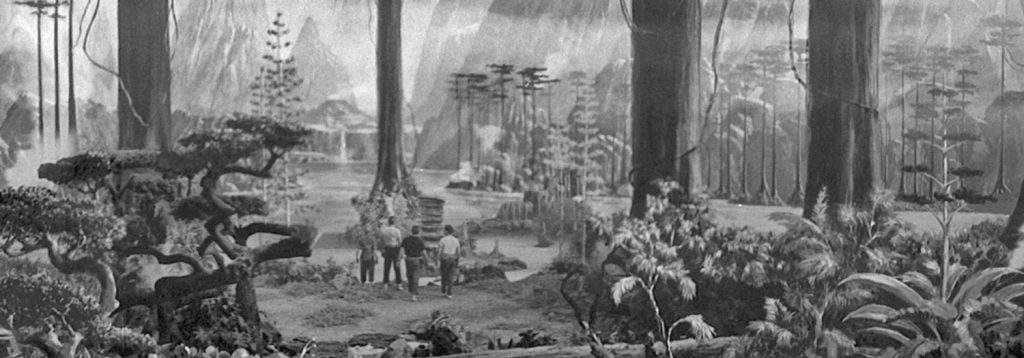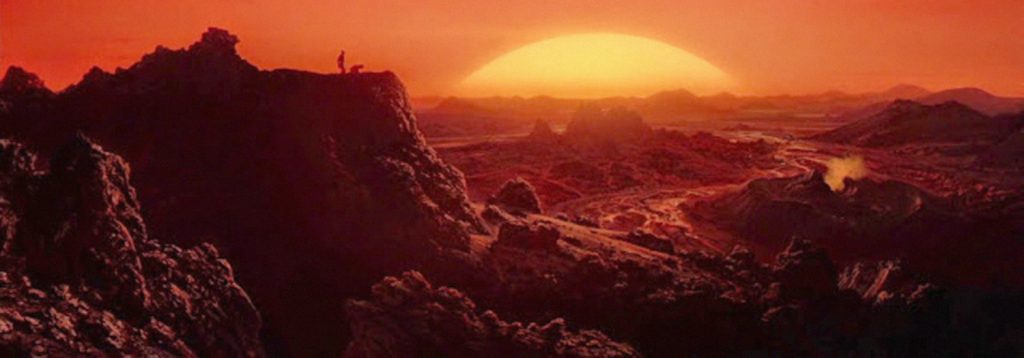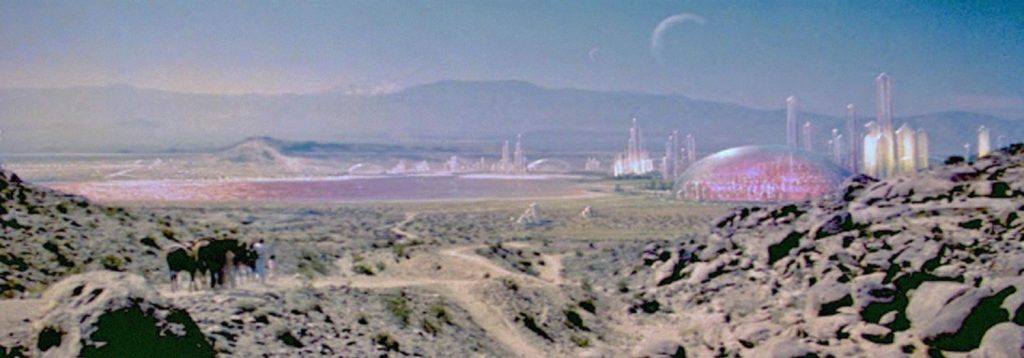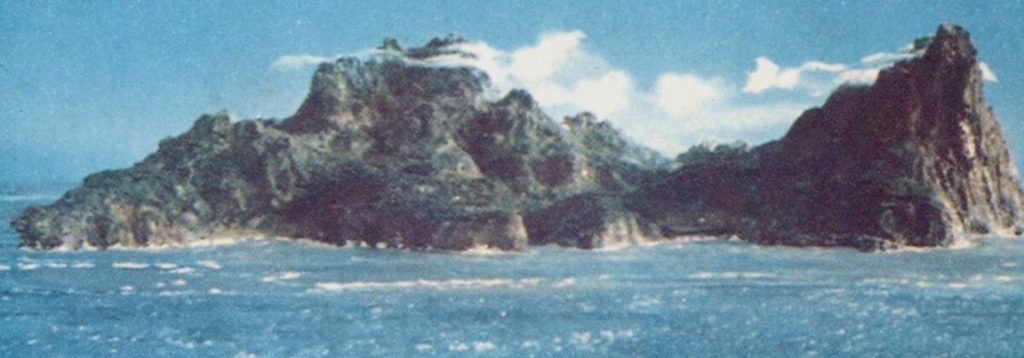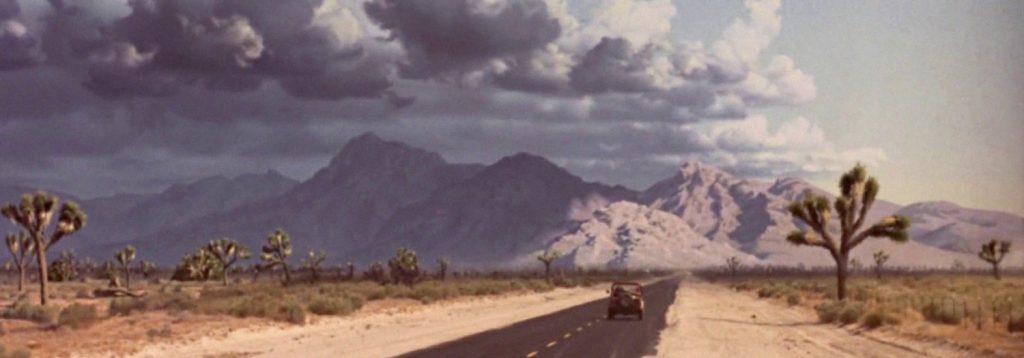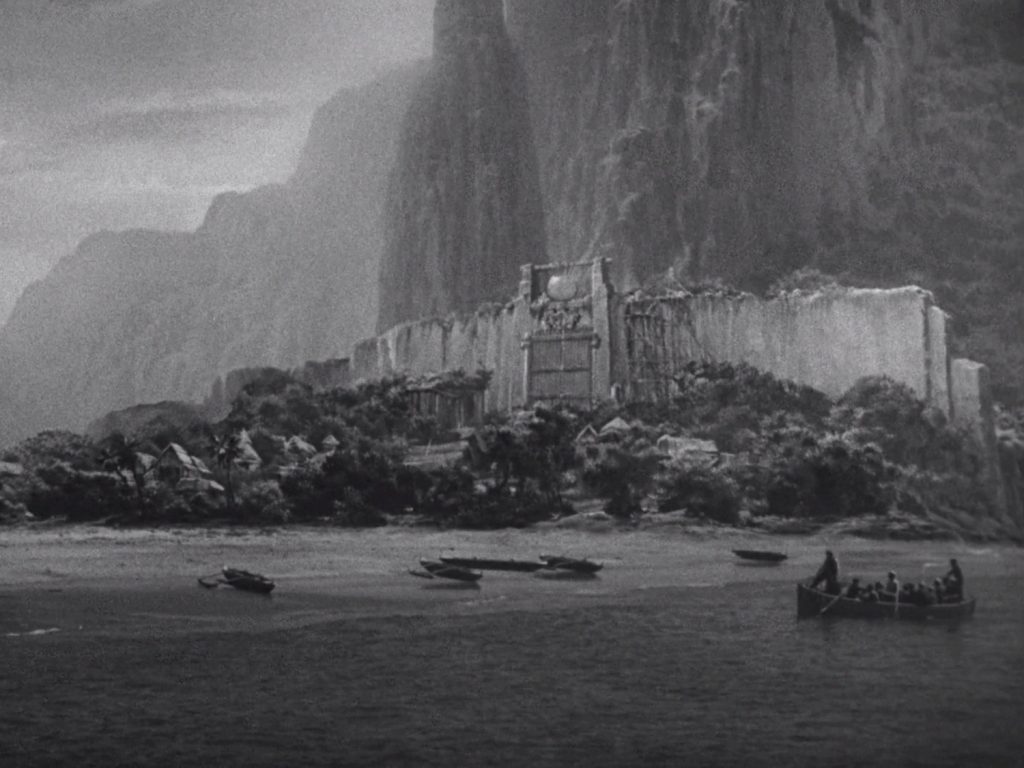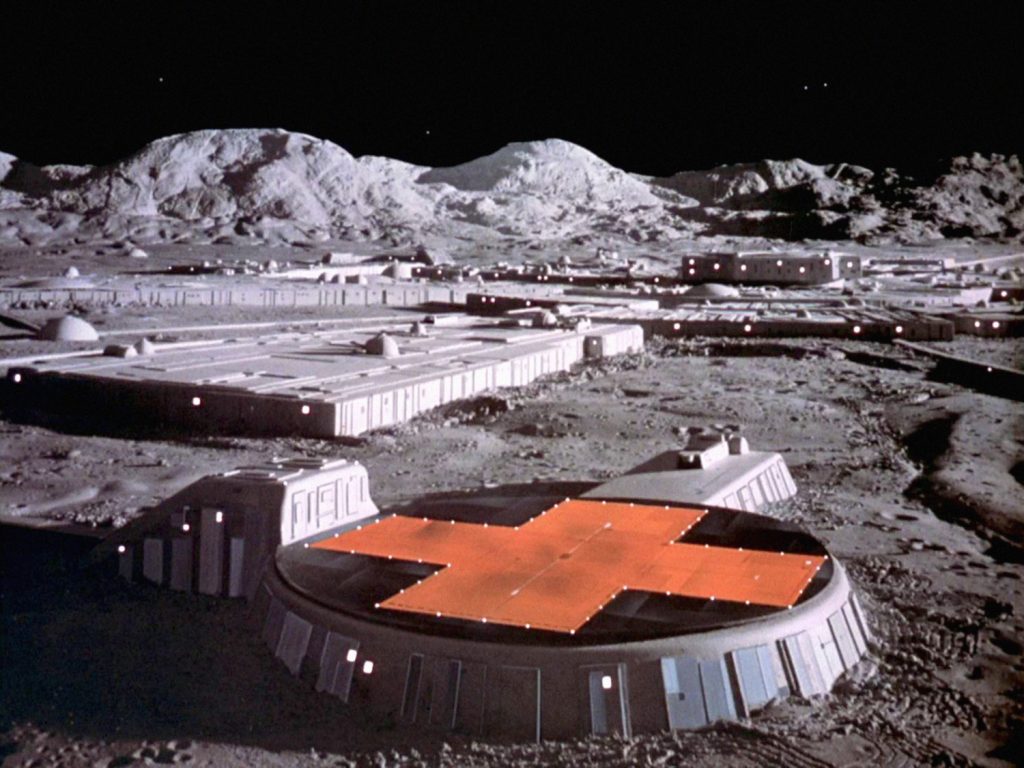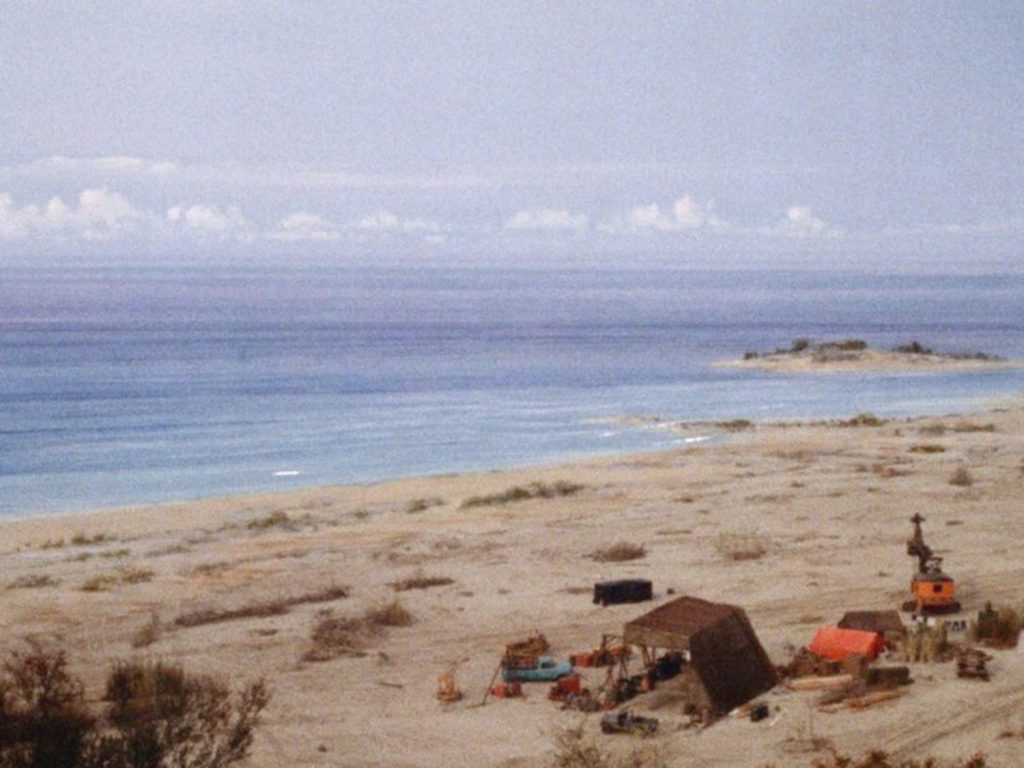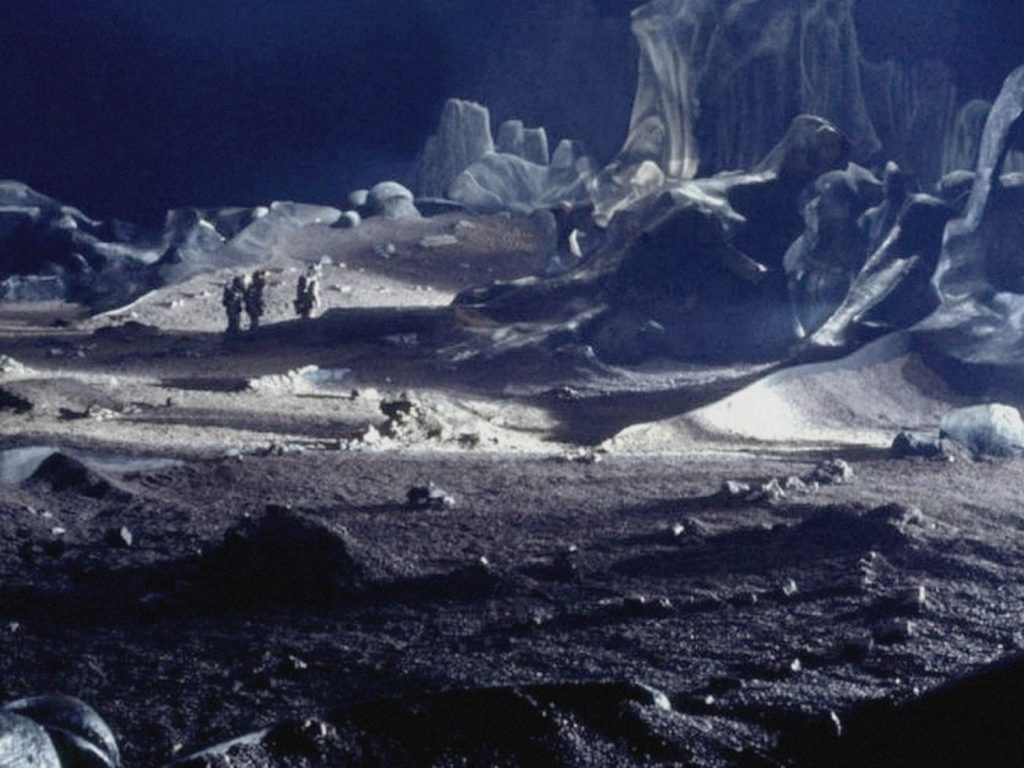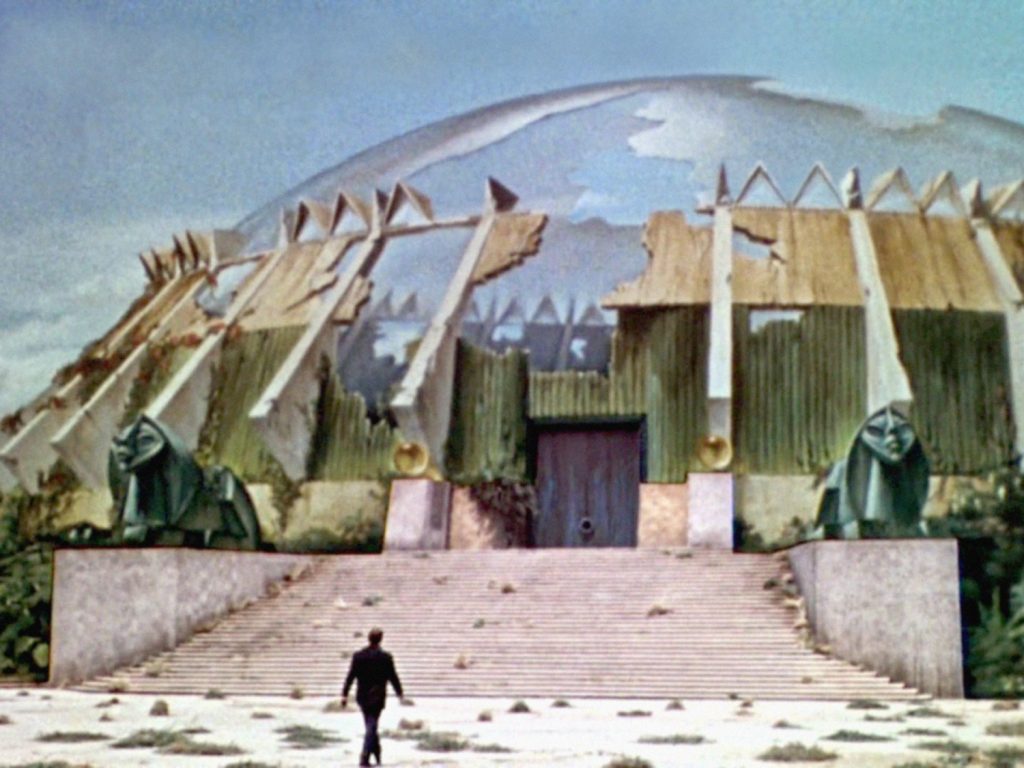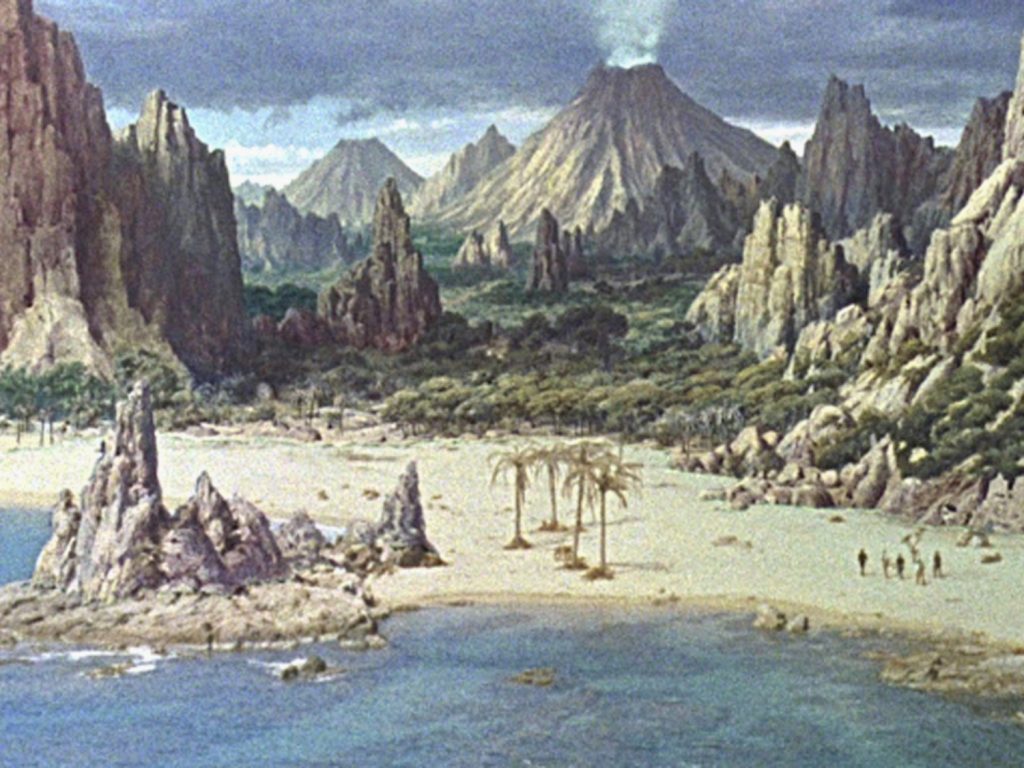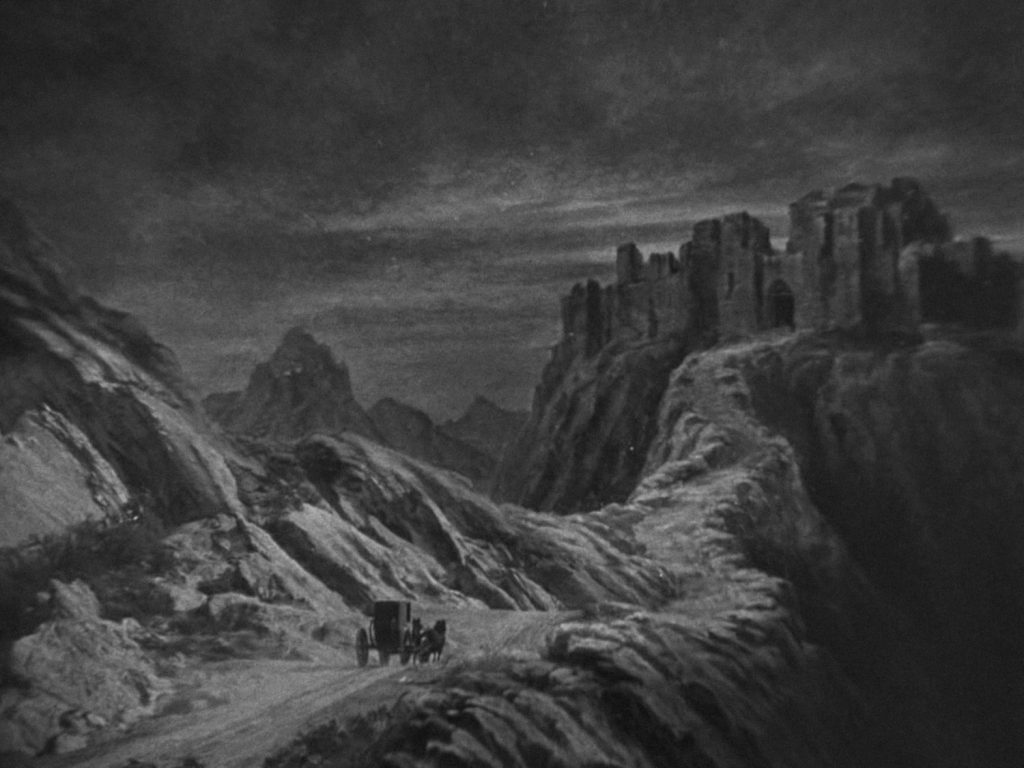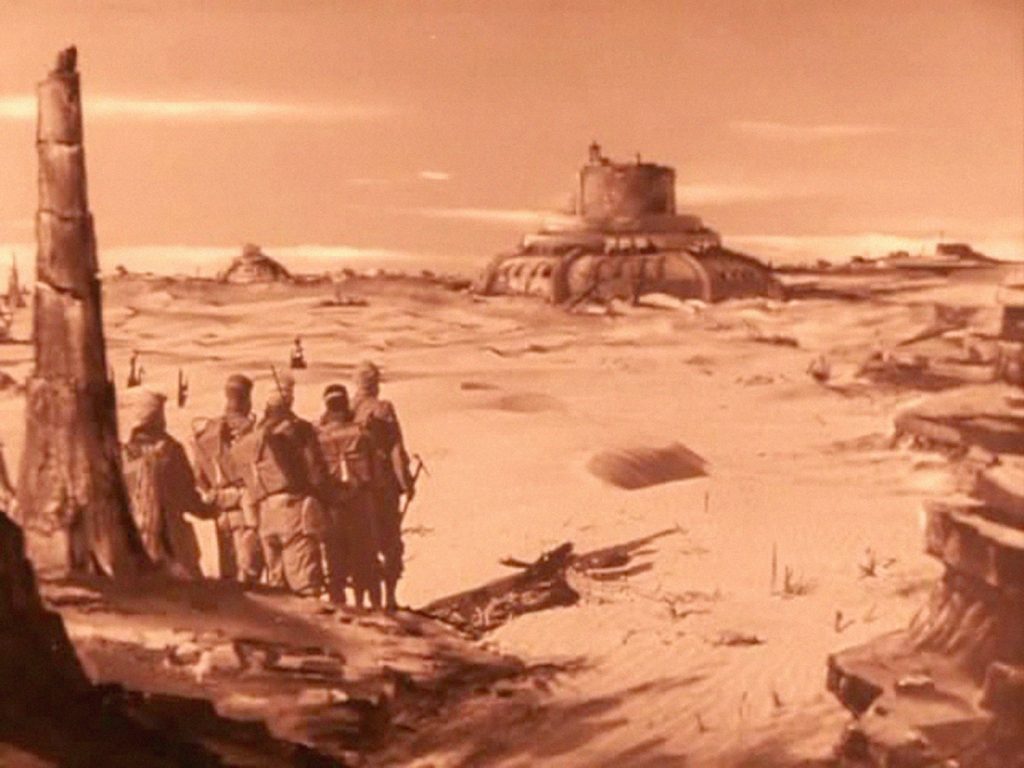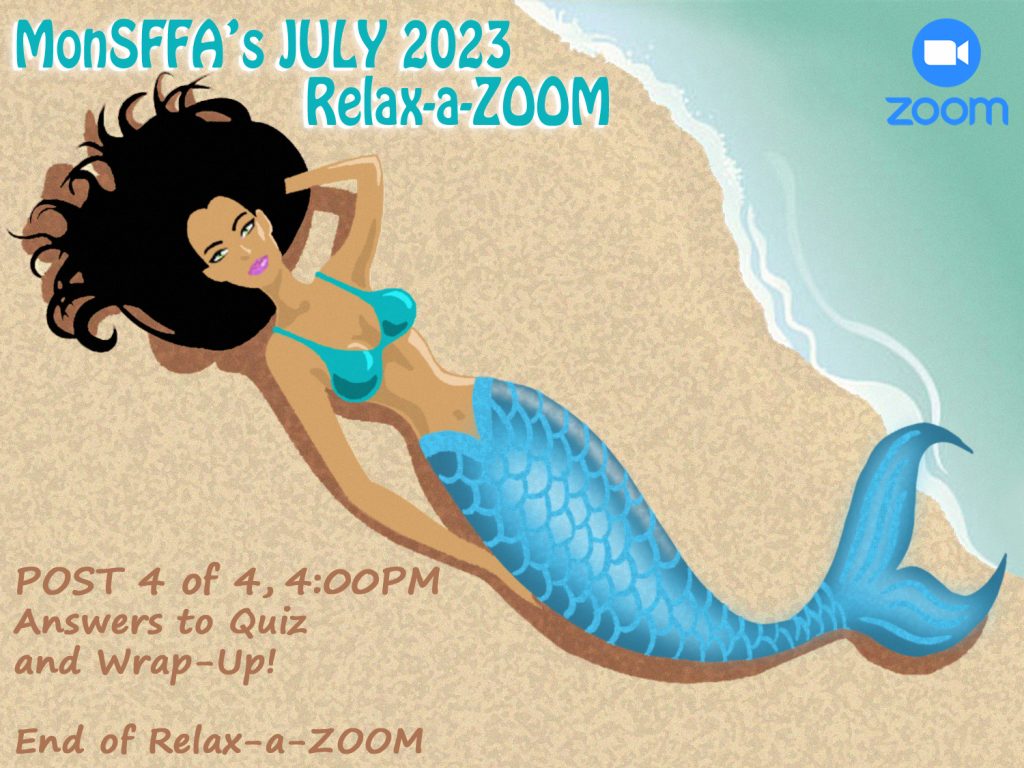 This is the closing post of our Relax-a-ZOOM.
This is the closing post of our Relax-a-ZOOM.
9) ANSWERS TO SF/F GEOGRAPHY QUIZ
A note before we provide the answers to our quiz: the artists and craftspeople who created for the screen these fantastical worlds of the imagination are often the unsung talents of genre filmmaking, sometimes working uncredited. Where information is available, we have given them their due recognition.
Following are the answers to our SF/F Geography Quiz, which we posted at 1:00PM. How well did you fare? Compare your answers to these:
Panoramas
Renowned space artist Chesley Bonestell was engaged to paint this vista of the planet Zyra, to which a rocketship of people escape on doomsday, when the rogue star Bellus collides with and destroys Earth. Zyra had been orbiting Bellus as the two celestial bodies entered our solar system. Passing close to Earth, Zyra just missed striking our planet only days before Bellus ultimately hit, offering humanity’s few survivors a habitable new world.
The story behind this painting is that, apparently, Bonestell had not entirely completed the work when it was hastily conscripted to depict Zyra at the insistence of the studio, who wanted to release the picture as soon as possible in order to capitalize on the popularity of producer George Pal’s previous film, Destination Moon (1950). Effectively pre-production art, the painting was meant to serve as a guide for the construction of a miniature landscape of Zyra, Pal’s original plan, but the studio nixed that idea and he was forced to compromise.
Jan Domela was the uncredited matte artist on this production.
2) The 7th Voyage of Sinbad (1958)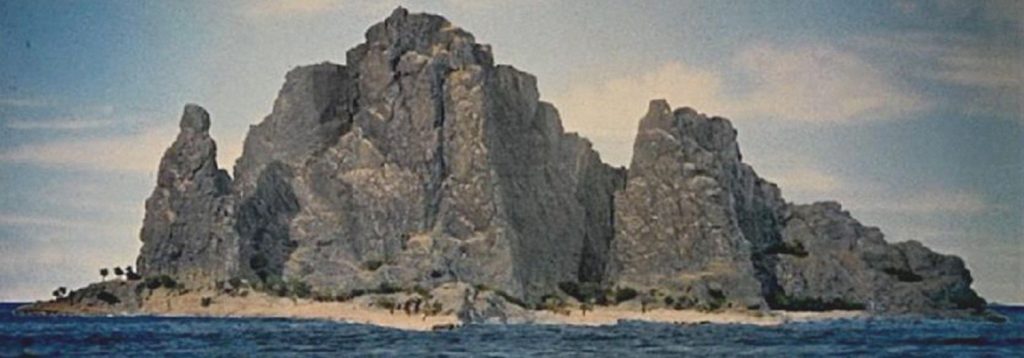
This is the island of Colossa, where Sinbad and his crew encounter a number of mythological beasts, including the monstrous cyclops, who dwell in a valley at the center of the island.
The uncanny denizens of Colossa were brought to life on screen by means of stop-motion animation executed masterfully by Ray Harryhausen, his wonderful creatures performing on miniature sets and melded with previously photographed live-action footage.
Colossa, here, is a miniature with the ocean composited in to complete the shot.
After making his way north, to the Arctic, a young Clark Kent throws a Kryptonian gemstone miles into the distance, where it melts into the ice and gives rise to a crystalline structure, the Fortress of Solitude.
Most of this image is a matte painting produced by the film’s Oscar-winning “mattes and composites” team, headed by Canadian-born Les Bowie, an accomplished matte artist himself, and veteran of Hammer Films.
4) Raiders of the Lost Ark (1981)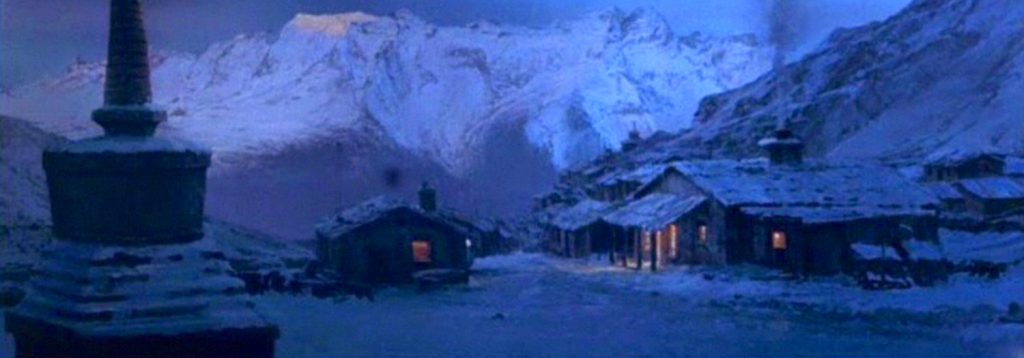
This full painting is of the Raven, circa 1936, Marion Ravenwood’s bar in Patan, on the outskirts of Katmandu in Nepal. Indiana Jones, who was once involved romantically with Marion, comes to the Raven in search of an important archeological piece collected by her father.
The artist, here, is Michael Pangrazio, who was also responsible for the iconic matte painting of the vast secret government warehouse in which the Ark is stored at the end of the film.
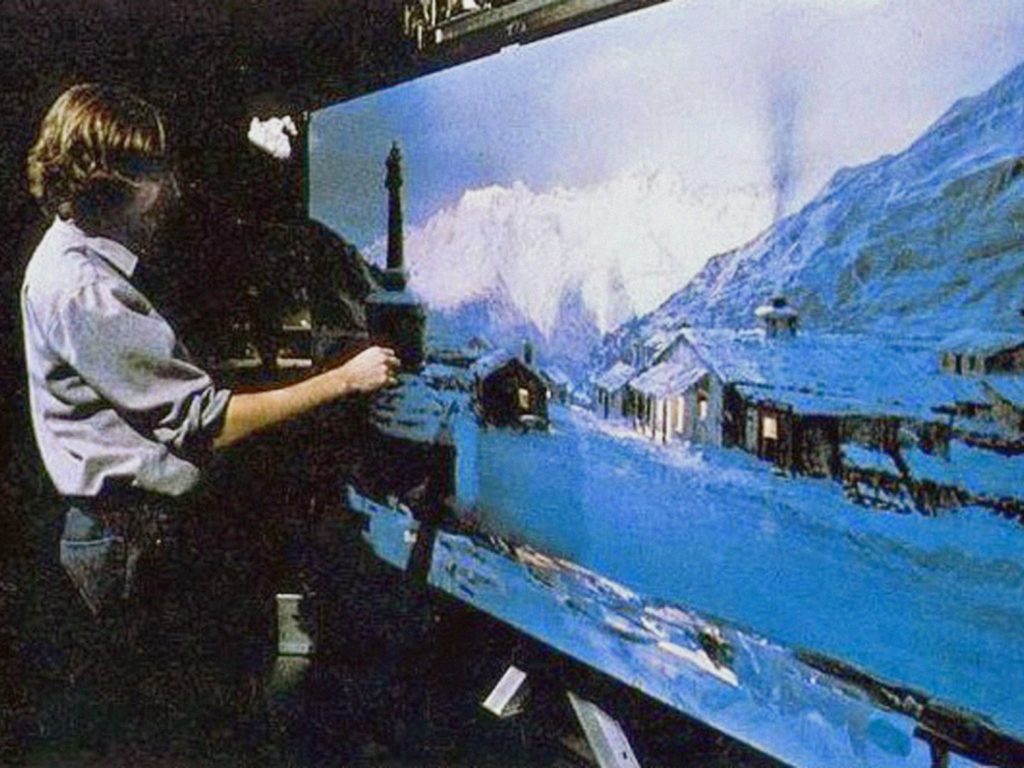
5) First Spaceship on Venus (1962)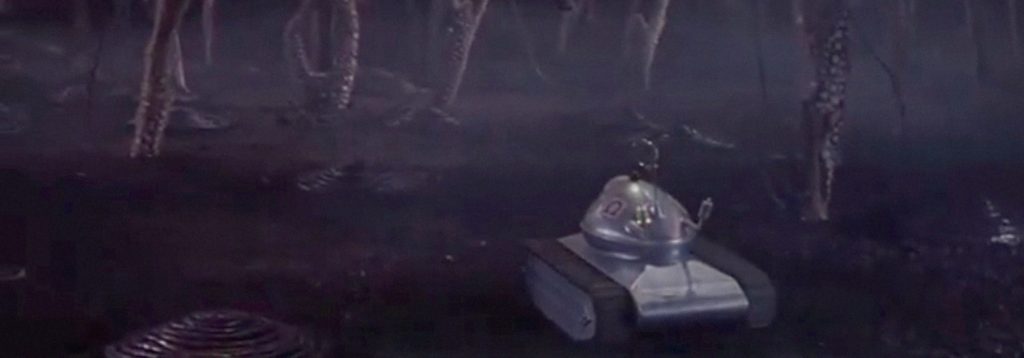
Omega, a robot probe accompanying astronaut-explorers from the rocketship Cosmostrator, negoiates the terrain of atom-blasted, windswept Venus in an example of quality production design from behind the Iron Curtain.
First Spaceship on Venus is the U.S. release of a 1960 East-German/Polish film entitled Der schweigende Stern (German), or Milcząca Gwiazda (Polish)—English translation: The Silent Star. Based on Astronauci—in English, The Astronauts—by Polish science fiction writer Stanislaw Lem, the state-owned East-German production studio, DEFA, made certain that socialist values were reflected throughout the film. First Spaceship on Venus is an English-dubbed, truncated edit of the original; versions were also released under the titles Spaceship Venus Does Not Reply and Planet of the Dead.
This view of the Belleraphon crew’s graveyard on the distant planet Altair IV is a full painting by Henri Hillinck, assisted by his student, Matthew Yuricich, who would go on to become one of the most accomplished practitioners ever of the so-called “Invisible Art.”
The Belleraphon was a spaceship the unknown fate of which brought Captain J. J. Adams and his crew, aboard the United Planets cruiser C-57D, to Altair IV in search of answers. Forbidden Planet was the first science fiction film to portray FTL travel by humans in a spaceship of their own construction, and the first to take place entirely on an alien planet in interstellar space, far, far away from Earth!
This is Sky City, home to the Hawkmen of planet Mongo, one of the locales visited by Gordon and his companions in a flashy (pun intended!) big-screen version of the Buster Crabbe sci-fi/adventure serials of the mid-1930s and 1940.
In this composite of matte painting and live-action footage, American Stephen Reinhart is on his way to visit fiancé Susan Witley at her familial home in Arkham, England and comes across a decimated landscape surrounding a pit on the Witley estate. Toxic radiation emitted by a meteor that crashed on the estate has caused hideous mutations in the local flora and fauna, including Susan’s mother and father, the latter played by horror icon Boris Karloff.
Doug Ferris and Peter Melrose were the uncredited matte painters on this Shepperton Studios production, loosely based on H. P. Lovecraft’s “The Colour Out of Space.”
This is the 100,000-year-old Antarctic crash-site of a flying saucer as pictured in John Carpenter’s terrific feature-film adaption of the 1938 science fiction/horror novella “Who Goes There?” by John W. Campbell, writing as Don A. Stuart.
The tiny figures atop the saucer are actors; master matte artist Albert Whitlock provided the wrecked saucer and surrounding snow-covered landscape.
Described as “the Monet of matte painting,” Whitlock was awarded the Best Visual Effects Oscar for his work on Earthquake (1974), a career-highlight, and repeated in the same category for The Hindenburg (1975). The Thing was among his final projects.
The movie’s sprawling city of the future is a detailed miniature akin to a large model railroad set-up.
In the 23rd century, the populace enjoy a hedonistic lifestyle within this utopian, computer-controlled, domed city. But the whole thing is a façade; this is, in reality, a dystopia as people have imposed upon them a shortened lifespan in order to keep population numbers and a limited food supply in balance. Couched in quasi-religious ceremony so as to assuage the public, all citizens are compelled to undergo the rite of “Carrousel” at age 30, in which they are systematically killed with a promise of “Renewal.” It’s all a lie, and those who attempt to flee the city so as to dodge their fate are called “Runners,” and are hunted down and executed by a special police force, the “Sandmen.”
The special effects team that earned an Academy Award for its work on this film included matte artist Matthew Yuricich, whose depictions of Washington, D.C., a dead city overgrown with vegetation, are entirely convincing.
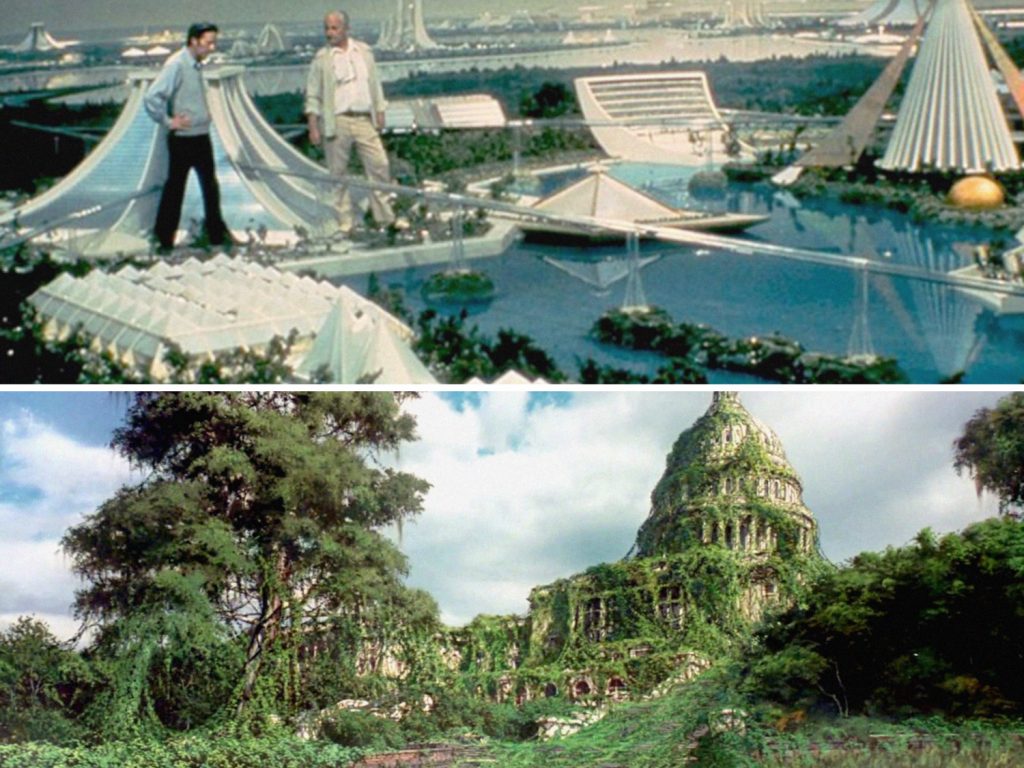
The film’s protagonists are awestruck by the scene before them, that of a steamy prehistoric jungle world they have discovered deep within an Antarctic crater.
Much of the action was filmed on a studio set ringed by a huge painted backdrop called a cyclorama. For wide shots, the actors were composited into miniature sets populated by dinosaur puppets or crewmembers dressed in dinosaur suits.
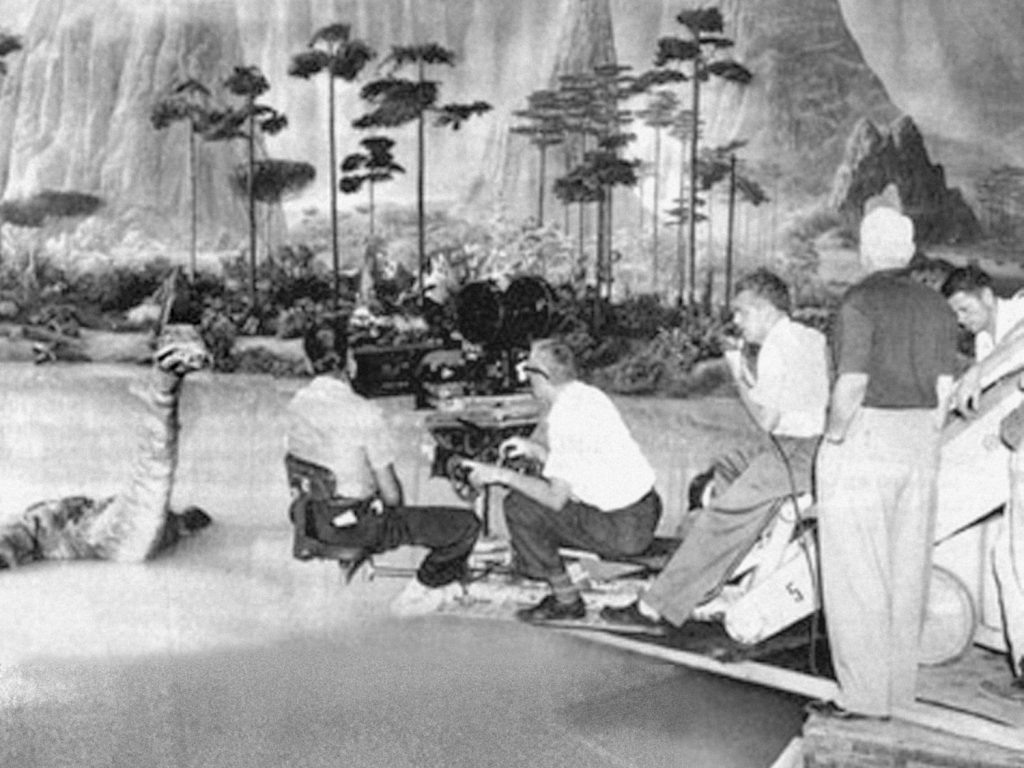
12) Colossus: The Forbin Project (1970)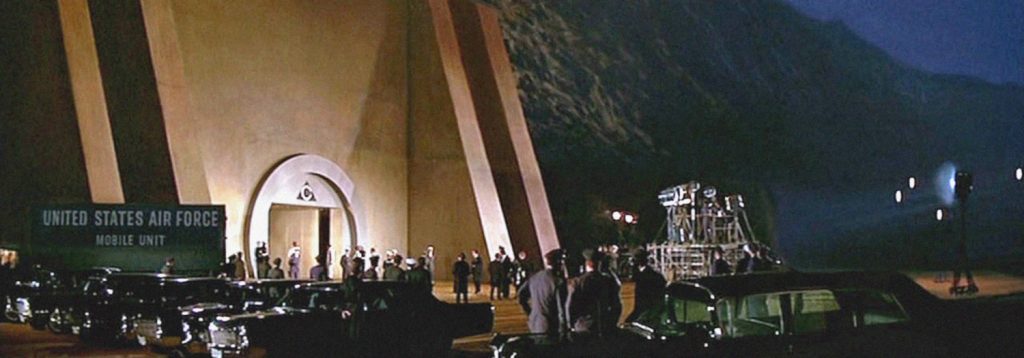
This is the exterior of the military installation carved into a Colorado mountain that houses defense supercomputer Colossus. Once Colossus is activated and the vault shut, the complex will be impregnable.
Celebrated matte artist Albert Whitlock provided several beautifully rendered oil-on-glass mattes for this film.
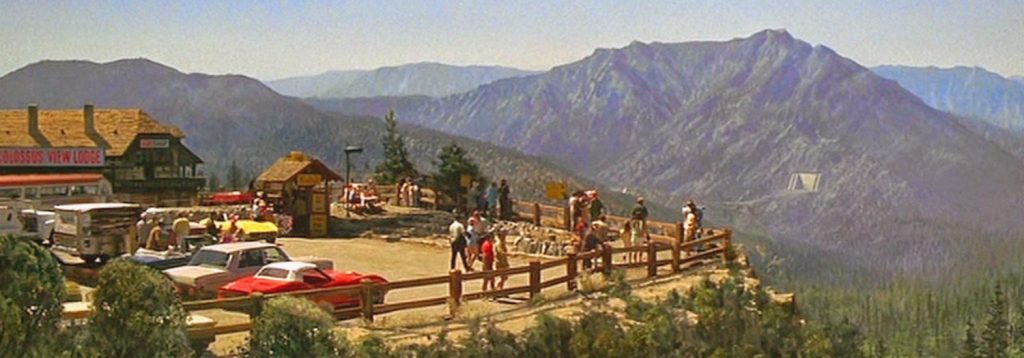
This is the inhospitable, largely volcanic planet Fyrine IV.
During an interstellar war pitting the human race against the reptilian Dracs, two opposing fighter spacecraft engage in a dogfight that ends with both ships crash-landing on Fyrine IV, where the human pilot and his Drac counterpart must set aside hostilities and cooperate in order to survive. The two eventually become fast friends.
Matte artist Sean Joyce was reportedly inspired by a similar Albert Whitlock-rendered sunset scene in Greystoke: The Legend of Tarzan, Lord of the Apes (1984).
The “City of Light” is a domed city of the far-flung future featured in this movie’s closing scene.
Jim Danforth, also known for his stop-motion animation work, painted the matte.
15) Star Trek II: The Wrath of Khan (1982)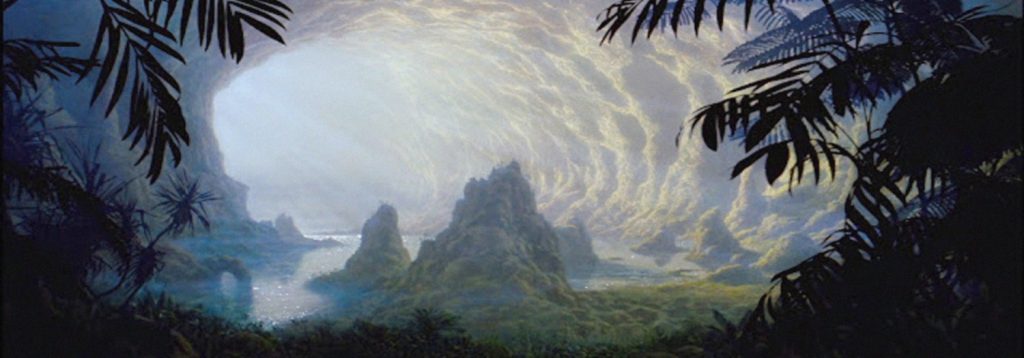
This is the Genesis Cave, as any Trekker will attest!
ILM’s Chris Evans and Frank Ordaz shared matte painting duties on Wrath of Khan.
16) Robinson Crusoe on Mars (1964)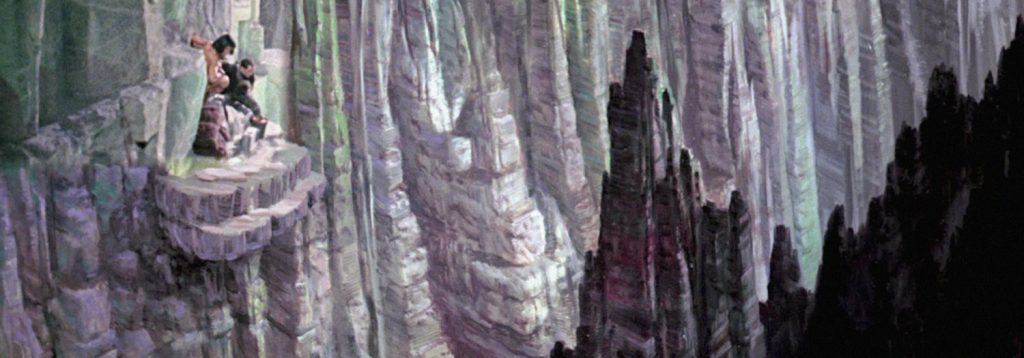
An uncredited Albert Whitlock lent his talents to the production as matte artist, producing several striking paintings, including this colossal Martian cave dwarfing the actors composited into the shot.
The movie offered a sci-fi take on the classic Daniel Defoe story.
This is Solgell Island in the South Pacific, site of weather-control experiments by scientists, and the birth place of Minilla, the adopted son of Godzilla!
Son of Godzilla was the title given the English-language dub of the original Japanese Kaijū-tō no Kessen: Gojira no Musuko, the literal translation of which reads “Monster Island’s Decisive Battle: Godzilla’s Son.” In 1969, Son of Godzilla was released theatrical in the U.K., but premiered in the U.S. not in movie houses, but on television.
With special effects by Sadamasa Arikawa, supervised by the franchise’s venerable Eiji Tsuburaya, the movie’s principal monsters were portrayed by actors in suits performing on miniature sets. The various other giant creatures of the piece were puppets.
Solgell Island was, effectively, what became known as Monster Island in later films.
Having survived her encounter with the Terminator, the film’s epilogue follows a pregnant Sarah Conner, who drives her Jeep into Mexico recording explanatory audio tapes. These she will one day pass on to her as yet unborn son, John, future leader of the Resistance. The closing shot sees her pull out of a gas station after filling up and drive away, down a desert highway into the coming storm.
Much of that composite shot is a matte painting by Ken Marschall, better known for his exceptional paintings of the ill-fated ocean liner Titanic.
Standard Frame
This is Skull Island. Visible are the beach, native village, and huge wall built to keep separate from the natives Kong, the dinosaurs, and other dangerous creatures that dwell on the island.
Byron L. Crabbe, Mario Larrinaga, and Henri Hillinck served uncredited as matte painters on this production; these gentlemen are among the pioneers of the process.
20) The Crater Lake Monster (1977)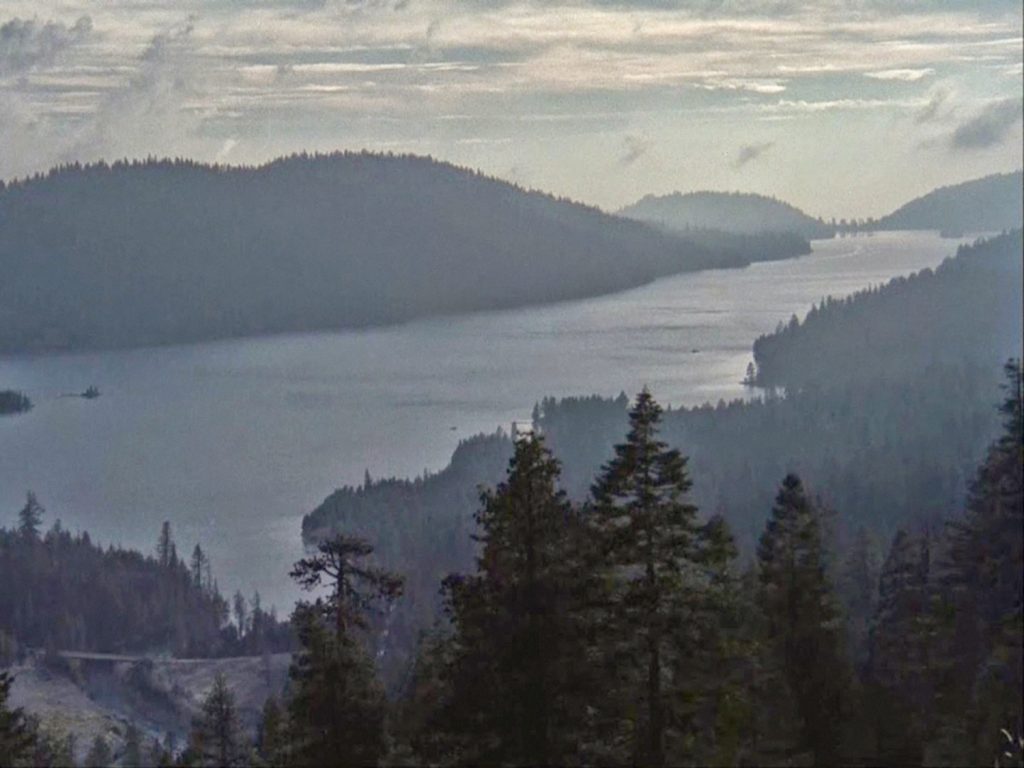
This is Crater Lake, California, setting of Crown International Pictures’ critically-panned, micro-budget B-movie about a Loch Ness monster-like plesiosaurus dining on tourists and townspeople. While the production shot on location at Huntington Lake, California, Crater Lake is a real-world locale in the northern region of the state, not to be confused with the well-known lake of the same name in Oregon, key feature of Crater Lake National Park.
The titular monster was brought to life by means of stop-motion animation, supervised by David “Dave” Allen, who was assisted by Jim Danforth and Randall William Cook, with Phil Tippett pitching in building miniatures. All but Allen working uncredited. Their collective efforts are the only thing about this truly awful, amateurish film that merits a look!
Pictured is Moonbase Alpha, principal setting of this British sci-fi television series created and produced by Gerry and Sylvia Anderson. In the year 1999, Moonbase Alpha, staffed by more than 300 personnel, is launched on a trajectory towards the unknown when a massive explosion at a nuclear-waste storage site on the far side knocks out of orbit and hurls the Moon uncontrollably out into deep space!
With the cutting-edge visuals of 2001: A Space Odyssey (1968) as inspiration for the show, the production drew upon 2001 alumnus Brian Johnson to serve as special effects director. Skilled model-makers Andrew Kelly and Martin Bower were recruited, as well.
Measuring some 12 feet in diameter, the Moonbase Alpha model was built of plywood sections, sheet and vacuum-formed plastic, and Perspex, with various commercial model-kit pieces affixed as surface detail. Reflective tape was used to craft windows. The surrounding lunar surface was formed with Plaster of Paris, and the distant mountains were simply black-and-white photographs enlarged and mounted on board.
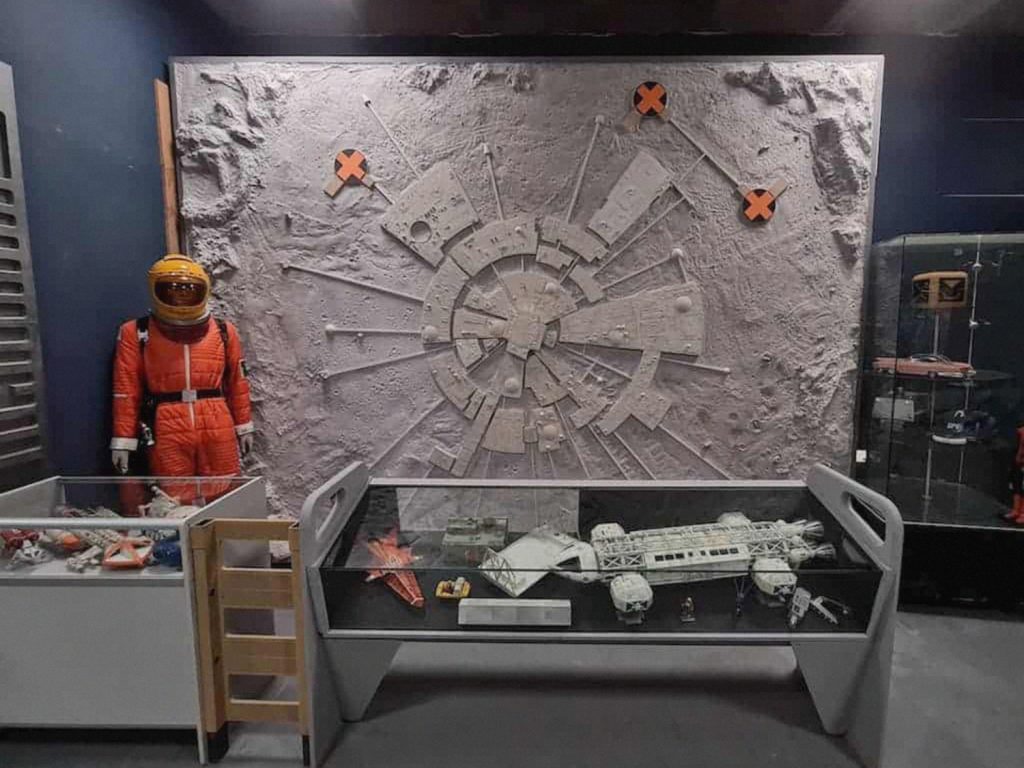
22) Star Trek—The Devil in the Dark (1967)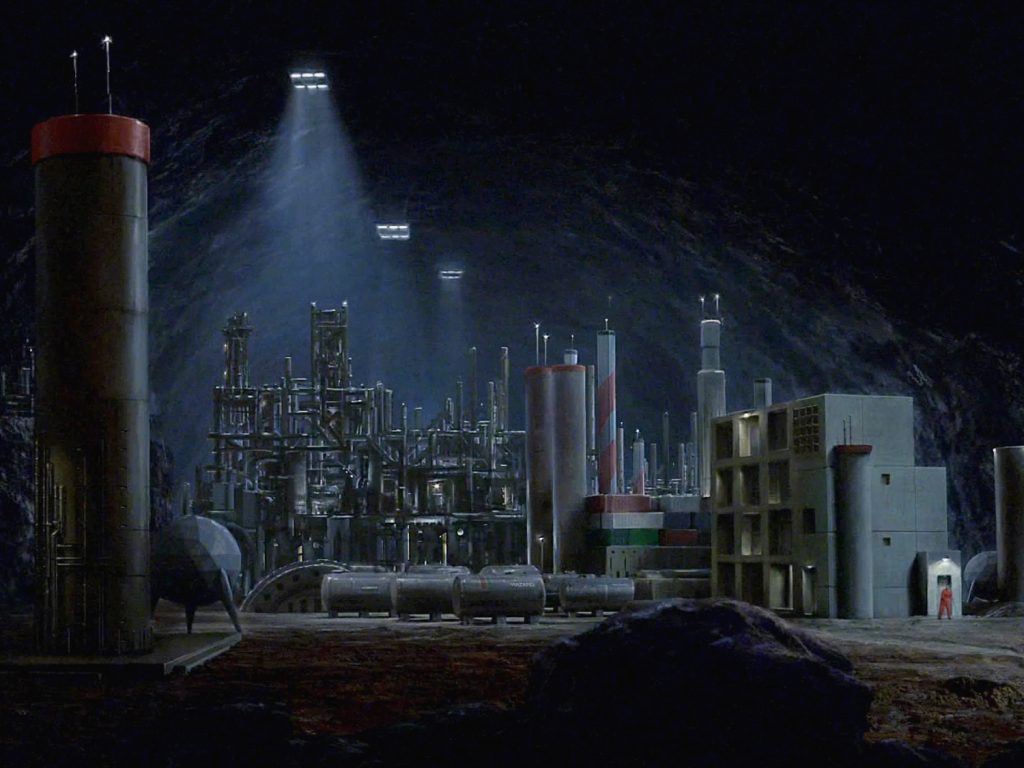
This is the pergium mining station on Janus VI, as seen in the remastered Star Trek episode “The Devil in the Dark.”
Max Gabl was assigned to create CGI imagery for the remastered version of this original series episode. Pictured is his digital matte painting of the mining facility. Live-action footage of an actor was composited in, bottom right corner of the frame.
In the late-1960s, Albert Whitlock was subcontracted to produce all of the matte paintings used in Star Trek, including the original establishing shot of the mining station, which was later repurposed as a backdrop in “The Gamesters of Triskelion” (1968). His magnificent Rigellian fortress is probably the most recognized of the many paintings he produced for the illustrious science fiction television series.
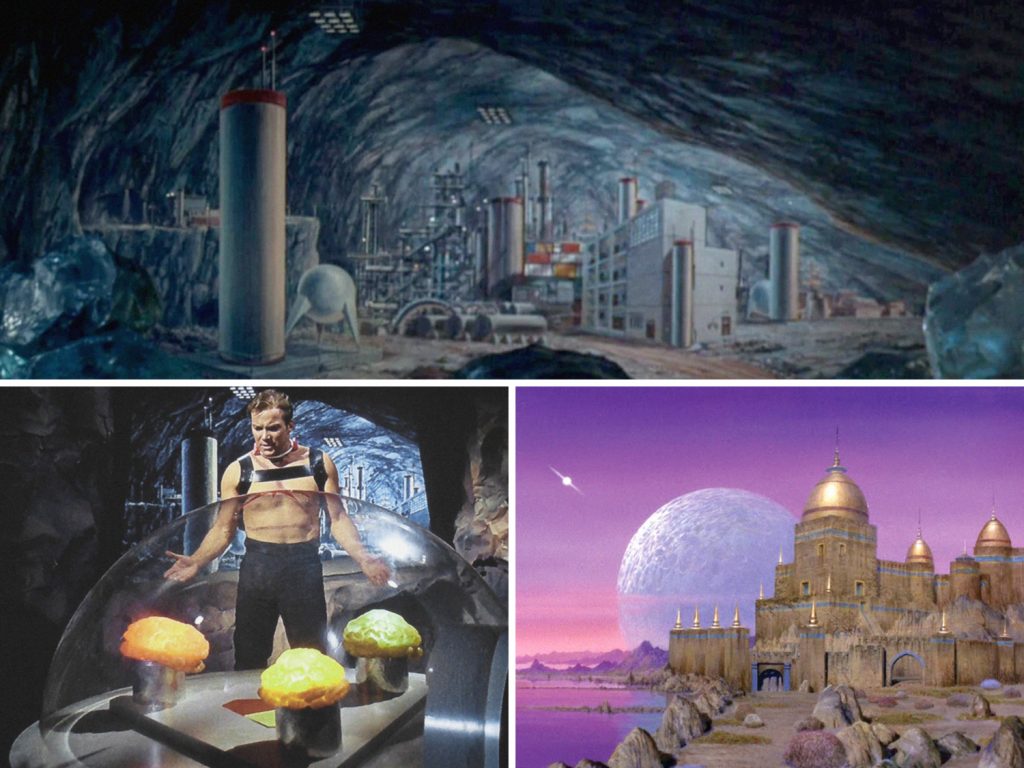
This is a small, uninhabited island about 200 miles off the east coast of Africa, on which a construction crew are in the process of building an airstrip for the Warburton company in advance of a planned oil-drilling operation.
Eons ago, this very locale was the site of a strange meteor impact. When the crew uncover the long-buried space rock during the course of their work, a glowing electric-blue light is emitted from the boulder, enveloping their large bulldozer and somehow imbuing the vehicle with a form of alien energy, a rudimentary sentience, and a homicidal bent!
Based on Theodore Sturgeon’s 1944 novella of the same name, Killdozer! was a made-for-TV movie that originally aired on the ABC network.
The movie was shot on location at Indian Dunes, a film ranch in Valencia, California. Albert Whitlock handled the production’s “special photographic effects.”
An EVA is underway, here, on the surface of LV-426 (later given the name Archeron), a moon orbiting the gas giant Calpamos in the Zeta II Reticuli system.
It is here that the doomed crew of the commercial starship Nostromo discovered the deadly Xenomorph, with only Warrant Officer Ellen Ripley surviving the encounter.
This was one of three large film sets built at Shepperton Studios for the production of Alien, the other two being the interiors of the Nostromo and the derelict spaceship. Wood and Fiberglas forms based on conceptual artist H. R. Giger’s designs were constructed and painted, and the set was dressed with tons of sand, gravel, and rock.
25) The Trollenberg Terror (1957)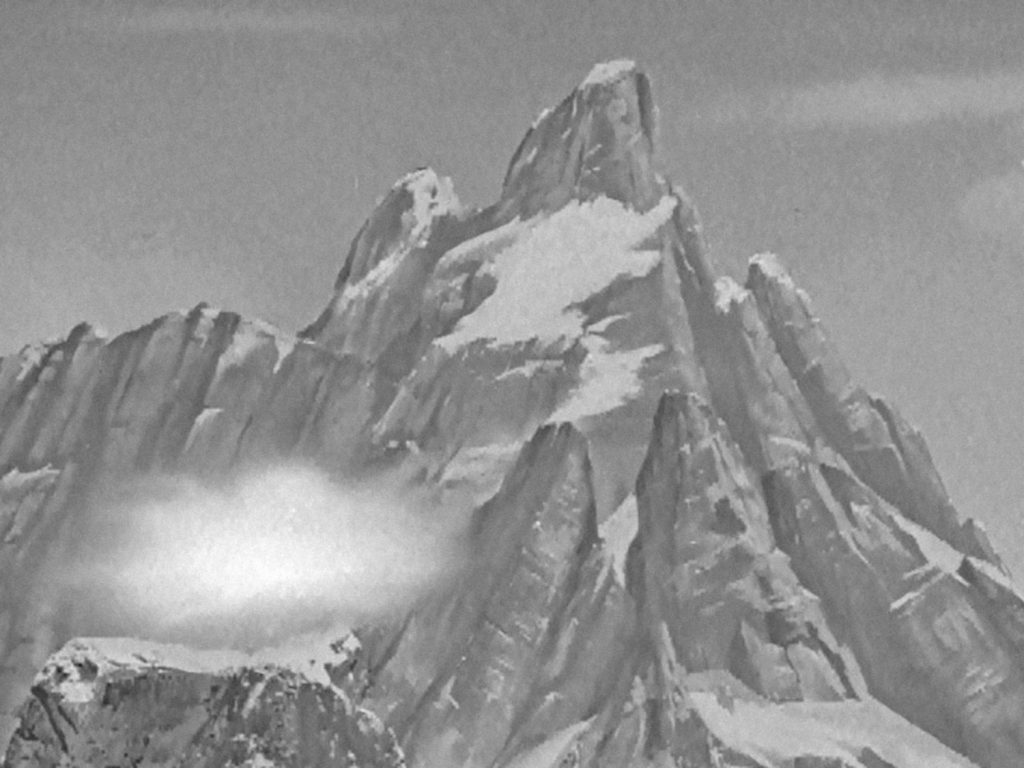
This view is of the fictional Mount Trollenberg in the Swiss Alps, where an odd cloud hugs the mountainside, concealing one-eyed, tentacled monsters! The British sci-fi/horror film was released in the U.S. as The Crawling Eye.
Les Bowie and assistant Brian Johnson executed the special effects, uncredited. The shot pictured here is a full painting onto which was affixed a cotton-wool cloud.
Approaching the ruins of the Eloi temple in this composite shot is Rod Taylor, as the time traveller identified only in dialogue as “George,” after both the film’s producer, George Pal, and science fiction author Herbert George “H. G.” Wells, whose story was the basis for the film.
Bill Brace was the uncredited matte painter on The Time Machine. The stairs in this shot were built for the film Kismet (1944) and saved for future use by a forward-thinking MGM executive; the rest of the temple is a Brace matte painting.
Designer/sculptor/model-maker/animator Wah Chang built the iconic time machine prop from a design by MGM art director Bill Ferrari. The film’s “time-lapse” effect, depicting the passage of years and centuries in mere minutes, earned the production’s special effects team an Oscar.
Largely a matte painting, this is a bird’s-eye view of the titular island, setting for a classic Jules Verne science fiction/adventure.
Regarding special effects, peerless stop-motion animator Ray Harryhausen is most associated with this movie. The matte artist who produced the painting, here, is uncredited; speculation by film historians believe credit is likely due either Les Bowie or his protégé, Ray Caple.
28) Jack the Giant Killer (1962)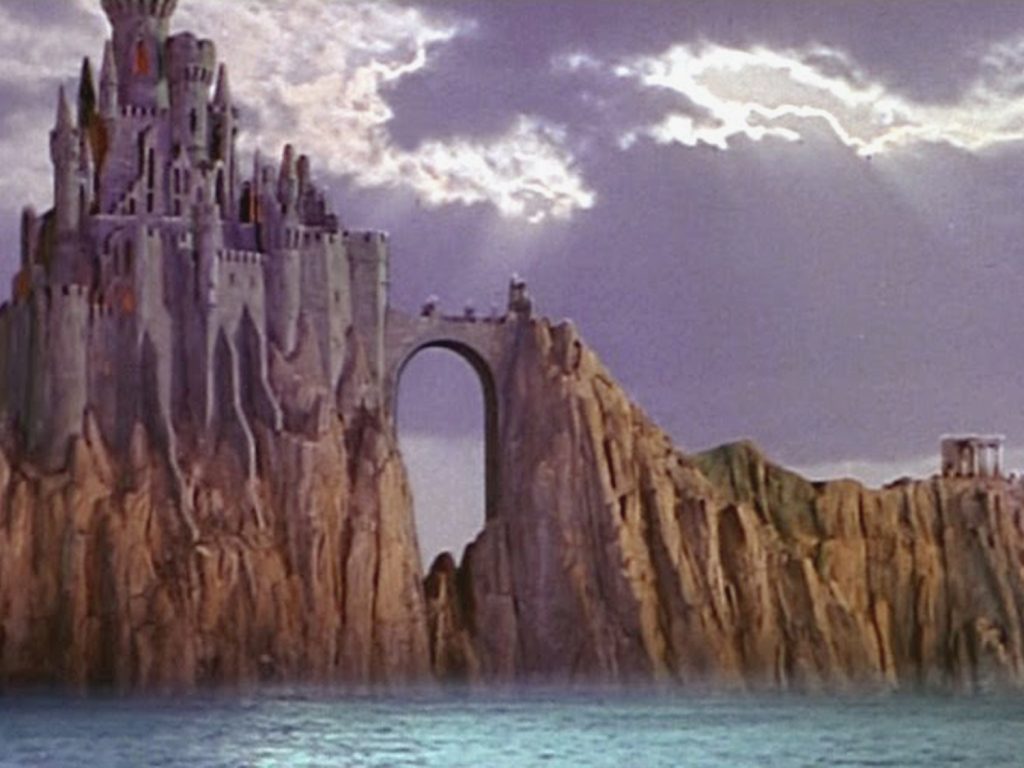
The grand castle of the tale’s evil sorcerer, Pendragon, is seen in this composite shot put together around Bill Brace’s matte painting of the imposing island fortress.
A blatant attempt to cash in on the popularity of The 7th Voyage of Sinbad (1958), many of the top young stop-motion animators and model-builders of the time worked on this movie, some credited, others not. They included Wah Chang, Tim Baar, Gene Warren, Tom Holland, and Jim Danforth.
A carriage makes its way up a steep, winding road in the Carpathian mountains towards baleful Castle Dracula.
The uncredited matte artist, here, was John P. Fulton, who worked his way up the ladder from assistant cameraman to cinematographer and eventually, head of the special effects department at Universal Pictures, and later Paramount Pictures. The classic Dracula was one of Universal’s series of popular horror films, circa 1930s-1950s.
Fulton, whose career spanned some four decades, is remembered in particular for his eye-catching work on The Invisible Man (1933) and its sequels, for his parting the Red Sea in The Ten Commandments (1956), and for the innovative special effects work in Alfred Hitchcock’s Vertigo (1958). Nominated multiple times in the Special Photographic Effects category, he was a three-time Academy Award-winner.
30) Cat-Women of the Moon (1953)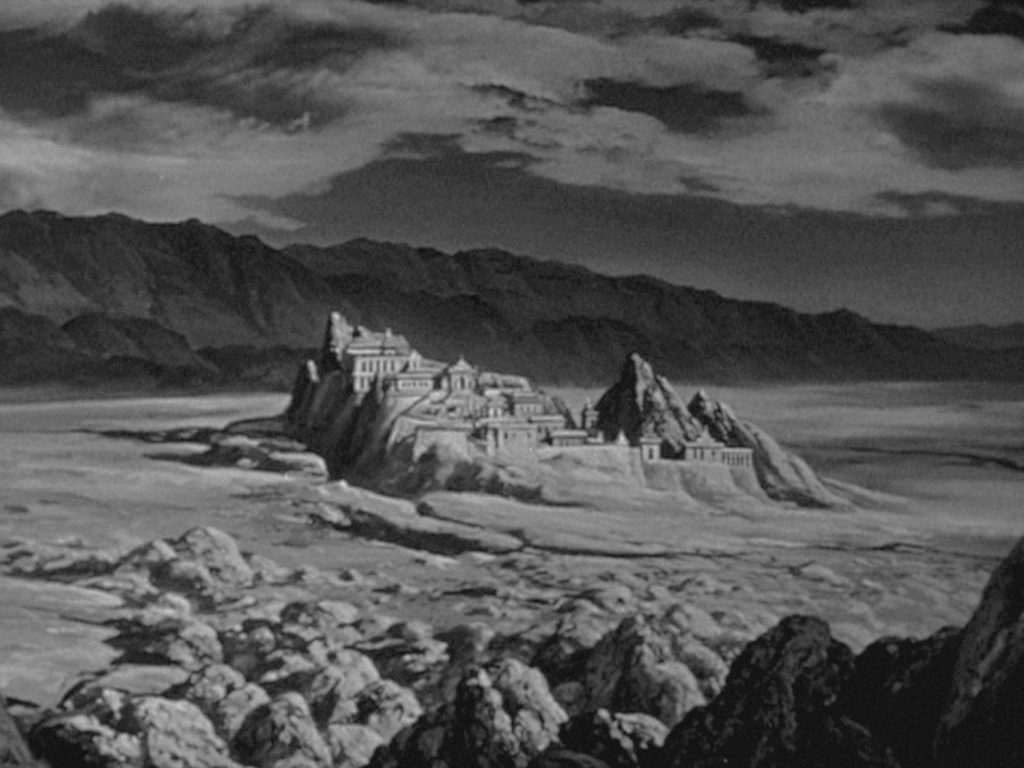
This is the moon city in which dwell the telepathic cat-women, who don black leotards, adorn themselves with pronounced mascara, and perform ritualistic dances. Their lunar oxygen supply diminishing, the cat-women plan to travel to Earth aboard a stolen spaceship and employ their telepathic powers to take over the world!
Co-producers Jack Rabin and Al Zimbalist came up with the story, and also saw to the film’s special effects, with associate Irving Block producing matte paintings for the film. Moonscape paintings were courtesy Chesley Bonestell, and Wah Chang fabricated a giant spider puppet for the sequence in which the Earth astronauts battle the eight-legged monster deep within the moon’s caverns. Block, Bonestell, and Chang were all uncredited.
31) The Time Tunnel (1966-1967)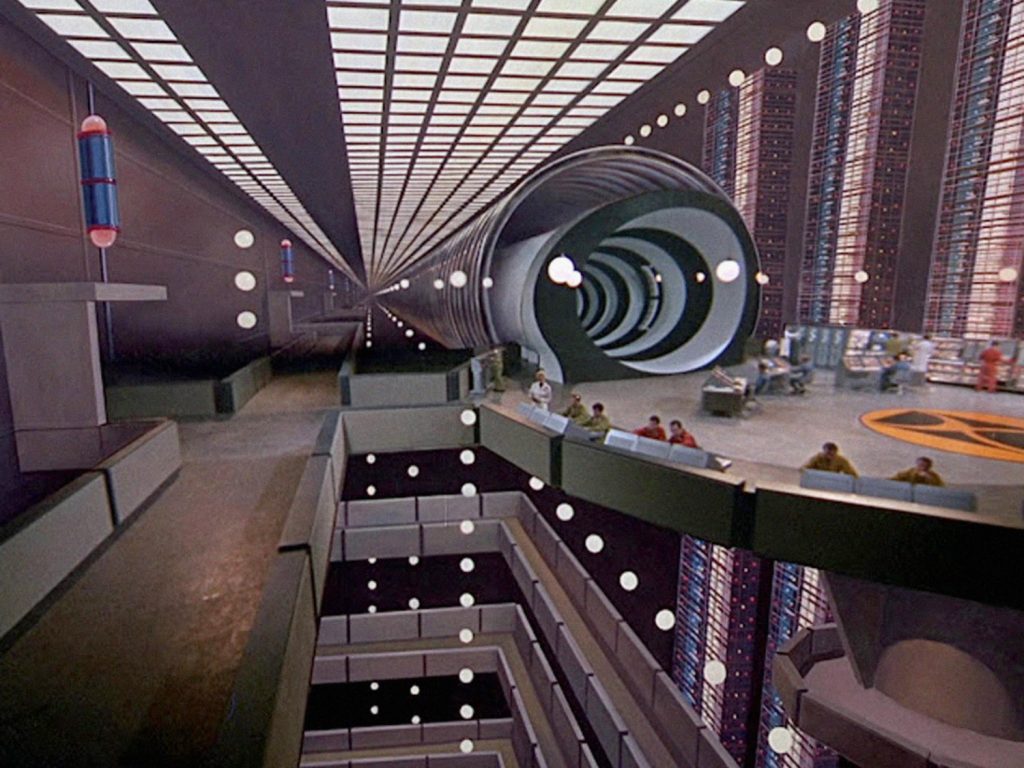
Project Tic-Toc, housed in a vast underground complex in Arizona, is a secret government experiment undertaking to construct a time machine. This establishing shot shows the resultant Time Tunnel and adjacent control room within the Tic-Toc complex. Most of this frame is a matte painting, artist unknown.
Hollywood legend L. B. Abbott, a cinematographer, special effects expert, and long-serving head of 20th Century Fox’s special effects department, was tasked with creating the special photographic effects for this short-lived Irwin Allen-produced television series. Among many other projects over a lengthy career, Abbott worked in this capacity on all of Allen’s mid-20th century sci-fi TV shows, as well as his various disaster movies.
32) The Quatermass Xperiment (1955)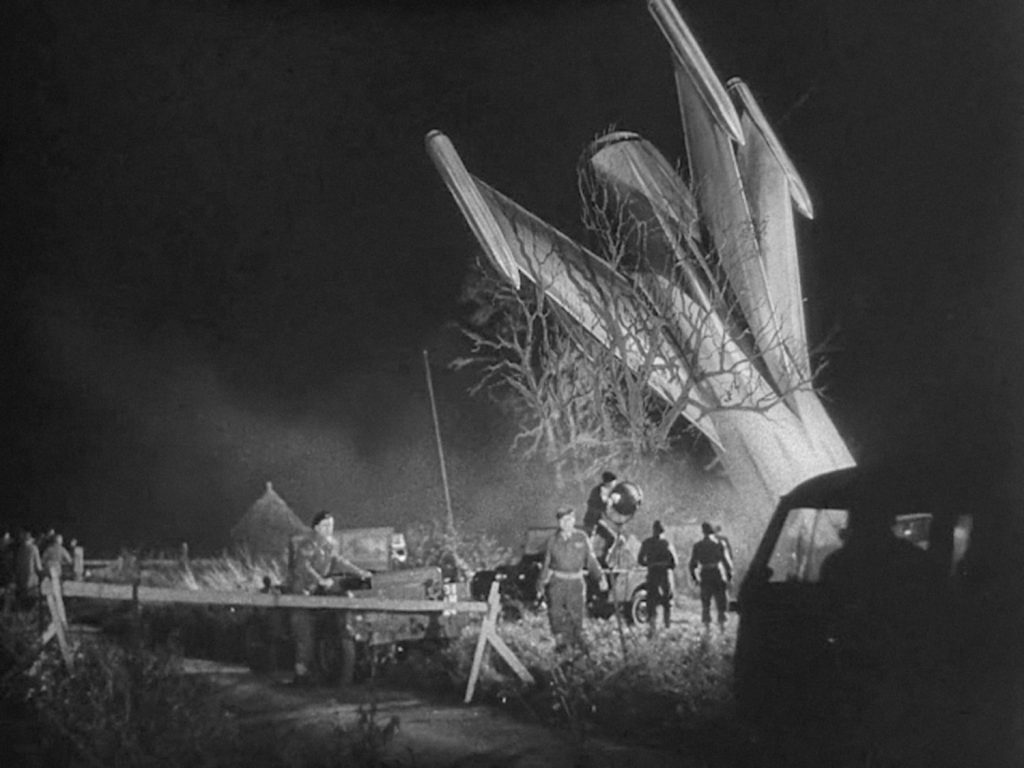
This is the crash site of the first manned rocket launched into space by scientist Bernard Quatermass’ group. After losing contact with the rocket and its three-man crew, the craft was found to have subsequently crashed in a field in the English countryside.
Working with a decidedly modest budget, Les Bowie and his special effects team managed some rather effective visuals. Here, everything above the actors’ heads is a Bowie matte painting seamlessly blended with the live-action footage shot on location. A corn field just outside the hamlet of Water Oakley, on the River Thames near Bray Film Studios, served as the crash site. Many Hammer films were shot at Bray Studios during the 1950s and 1960s.
The film was released in the U.S. as The Creeping Unknown.
33) The Valley of Gwangi (1969)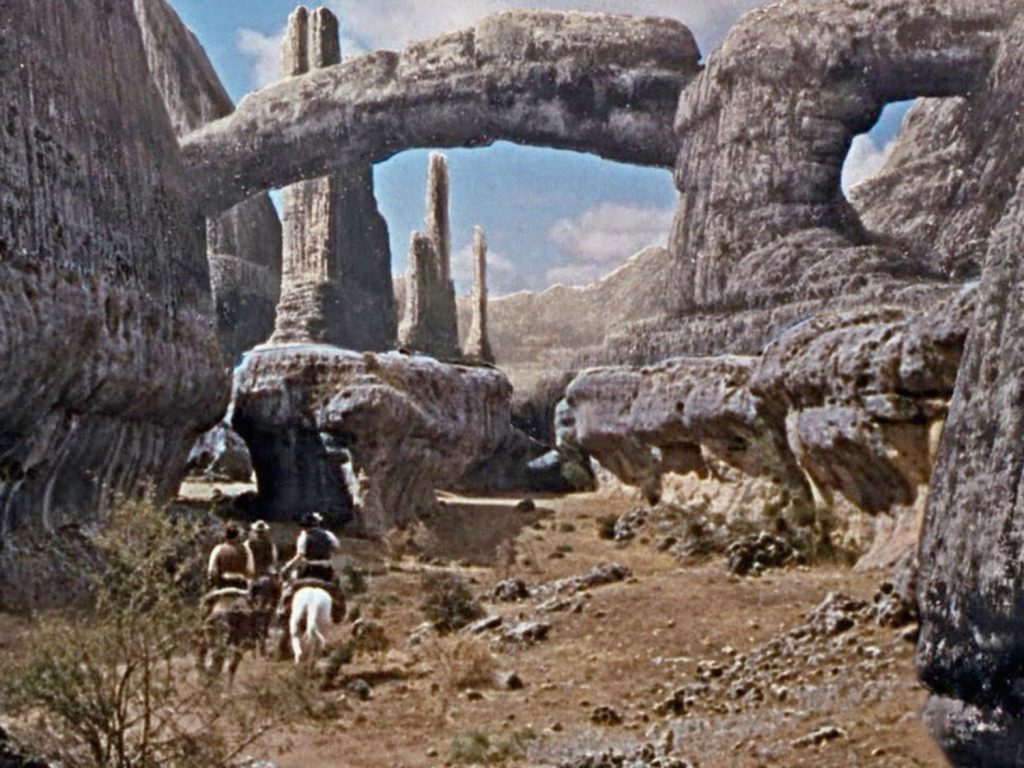
Gerald Larn, a resident matte artist at Shepperton Studios, was the uncredited matte painter who enhanced this Spanish filming location to deliver an introductory view of the Forbidden Valley, into which ride a posse of cowboys who will soon encounter Ray Harryhausen’s animated dinosaurs, most terrifyingly, the allosaurus Gwangi.
34) The Land That Time Forgot (1974)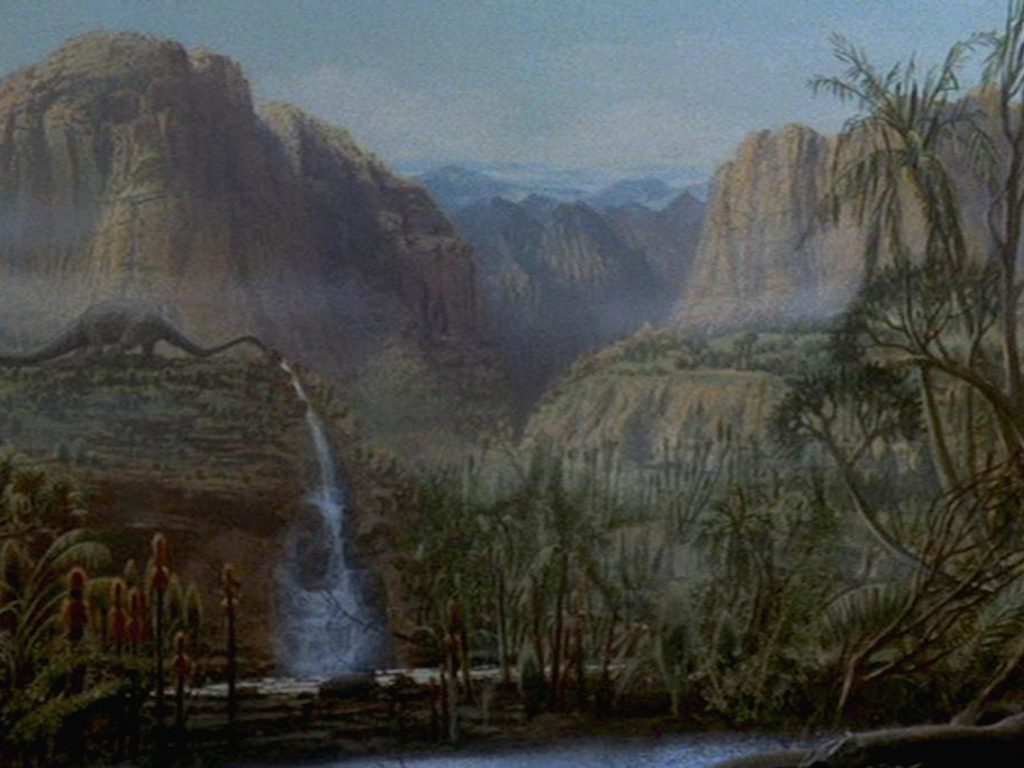
An animated dinosaur drinks from a waterfall in this composite shot of the lush, tropical interior of ice-bound Caprona, a fictional uncharted subcontinent in the South Atlantic, and the setting for this film adaptation of Edgar Rice Burroughs’ novel of the same name.
Credited as supervisor of special effects on the movie, Derek Meddings, famous for his work on Gerry and Sylvia Anderson’s Supermarionation television series, began his career in the 1950s as a matte painter under Les Bowie, rendering many a Transylvanian landscape for Hammer Films productions.
Eschewing stop-motion, the dinosaurs in The Land That Time Forgot were puppets crafted and operated by Roger Dicken.
35) The Monolith Monsters (1957)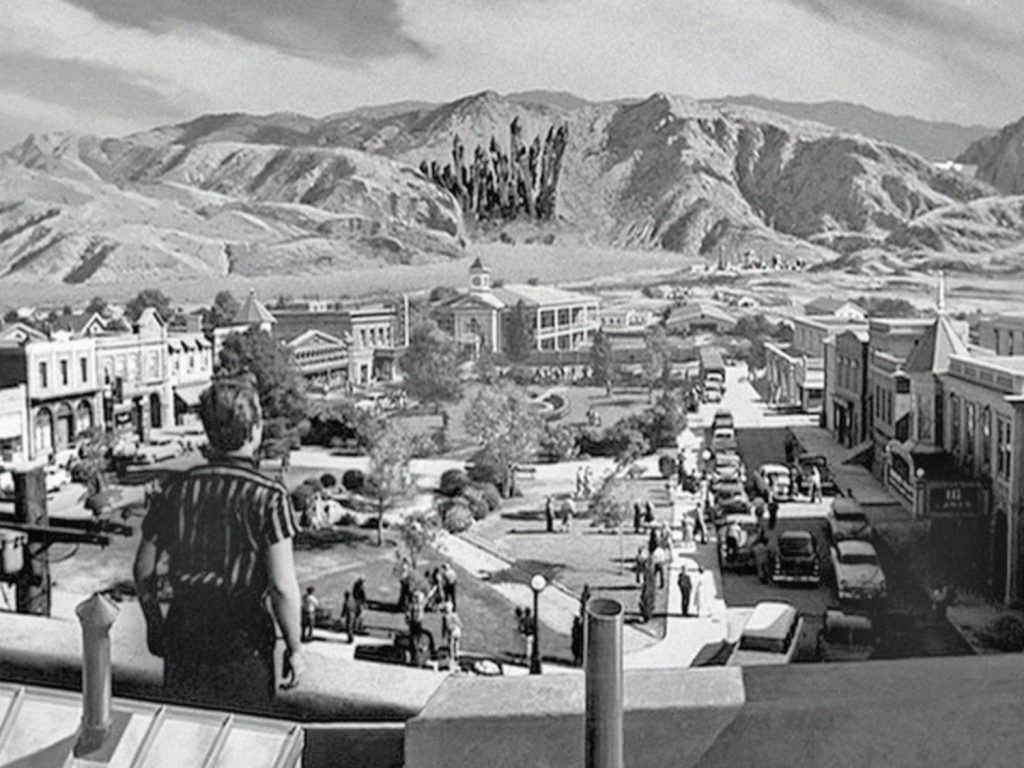
This is the small desert town of San Angelo, California, principal setting of the film. The shot is part real-world location, part matte painting, and part animated monoliths (visible in the distance). Journeyman matte artist Russell “Russ” Lawson, originally of St. John, New Brunswick, worked uncredited on the production.
With water acting as a catalyst, weird rock fragments of extraterrestrial origin grow into towering crystalline spires, then collapse, breaking into numerous pieces, each of which grows again to elevated heights. This ever-expanding rock formation methodically advances across the landscape, threatening the town, and ultimately, all of civilization! And if that wasn’t enough, any person coming in direct contact with these rocks is turned to stone!
This is the surface of Mars, where once flourished an advanced civilization, wiped out long ago in the maelstrom of an atomic war.
On course for the moon, the titular rocketship is unexpectedly hurled towards Mars, where the crew successfully land their spacecraft and begin exploring the Red Planet.
Irving Block was the matte artist on the film. While a black-and-white movie, a red-orange tint was applied to the Mars sequences.
10) THANK YOU!
We thank Keith Braithwaite and Cathy Palmer-Lister for putting this Relax-a-ZOOM together, and offer a nod of appreciation, as well, to all of our supporting contributors. And of course, we thank all who attended virtually today.
MonSFFA hopes you have enjoyed your time with us this afternoon, and we ask all of you to check in regularly here at www.MonSFFA.ca for additional content.
We look forward to again gathering, face to face, at August’s get-together, the first in-person meeting we’ve been able to schedule in over three years! Check back with us regularly in the weeks upcoming for more information on the August meeting.
Thank you for your interest and attention today, and don’t forget to comment on this afternoon’s e-gathering!
11) SIGN-OFF
Until we meet again, stay safe, keep healthy, and continue to enjoy your summer!

